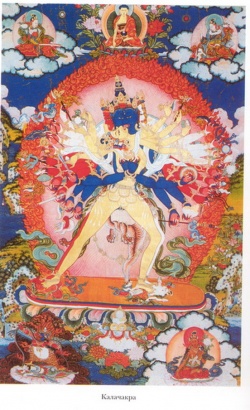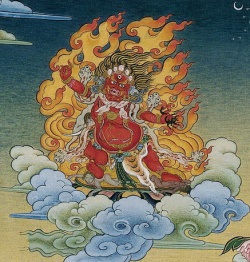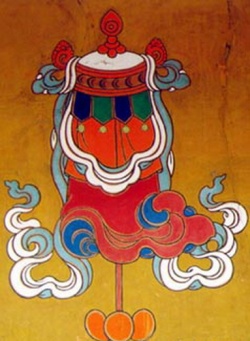Martial arts: Magnetic Girl
Magnetic Girl
Article from Cassiers's, January, 1895
by Nelson W. Perry, E. M.
"Seeing is believing," is an old saw that depends for its truth very largely upon the individual who sees. We most of us know, however, how fallible is the sense of sight; for it is upon this very fallibility that the sleight-of-hand performer depends for his success. He passes a coin from one hand to the other (or appears to do so), before your very eyes and then, after some diversion or other, in some mysterious manner, again shows the coins in the hand which it never had left. So prone is the eye to deceive itself, that when this simple trick is skillfully done, it will involuntarily follow the palpable itinerary of the coin hat its possessor knows full well it does not make.
Neither is the sense of hearing to be relied upon, else the ventriloquist's occupation, like that of Othello, would be gone. But who that has seen Heller or Hermann at his best, would not willingly see him again, though he knew that their performances were but tricks for the deception of the masses. Doubtless, the magicians of the East were adepts in this art, but their tricks have lost none of their mystery by the tales of travelers who have witnessed them. If it be true, as Barnum said, that the public likes to be humbugged, it is also true that this same public, after having been humbugged, itself delights in assisting other publics in becoming humbugged. It becomes a ready accomplice to the performer whose tricks it has itself witnessed.
The first exponent of this new art, if so it may be called, so far as the writer knows, was Miss Lulu Hearst, of Georgia. Some seven or eight years ago, rumors began to spread of the wonderful feats of strength performed by a slight country girl in that Southern State. She was described as pale and thin, about fourteen years of age, weight about 100 pounds, and of an extremely nervous temperament. Her weight and temperament were always emphasized, the first, doubtless, to show the impossibility of her accomplishing her feats by pure physical force, and the last, as hinting at occult powers which alone seemed adequate to the occasion.
So wonderful were her performances described to be, that people made long pilgrimages to see her and to marvel. Not alone were the uneducated mystified, but even those who pass for people of more than ordinary intelligence came away from her séances convinced with the idea that she was possessed of some inexplicable power, unknown to mortals of ordinary mold. Scientific men, while not sharing this belief in her occult or superhuman powers, were no less mystified. They proposed tests to which neither Miss Hurst nor her manager would consent; so they were left the only argument, that her powers were capable of explanation upon rational principles if it was but permitted them to find out what those principles were.
No less an authority than Professor Simon Newcomb, of the Smithsonian Institution, thought her feats worthy of investigation and he, with other well known scientists, made the pilgrimage to the little Georgia town where this new star was scintillating in all her brilliancy. He found her as described--young, slight and of nervous temperament, and her whole makeup apparently of such a character as to preclude, at first glance, the possibility of her performing her feats by means of her own, unaided, physical strength. He noticed, however, the play of the muscles in her arms and legs during the exhibition of her powers and discovered, as he thought and proclaimed, an abnormal development of the muscles.
His explanation, as widely published at the time, was in accordance with this assumed discovery. The enterprising dime museum manager saw in her a bonanza, and it was not long before she made the tour of the principal cities, and her fame was spread broadcast. Many imitators who had discovered the secret of her art, sprang up, and the Lulu Hurst's of the dime arena became plentiful. Some of these, indeed, far surpassed their prototype in skill and, while some assumed her name, others traveled upon their own reputations, made by performing all the tricks of Miss Hurst, together with others which were equally astonishing and originated with themselves.
It was one of these latter whom the writer first saw in a dime museum in Cincinnati. The performance took place upon a temporary stage, consisting simply of some rough boards loosely laid upon wooden horses at one end of a large hall. The performer was a young girl, pale and slender, and weighing probably not over 100 pounds. She wore short skirts so that the calves of her legs were partially disclosed to view, and her arms were bare. There was certainly nothing abnormal in the muscular development of either her arms or legs; it was, if anything, subnormal, or rather would I say, just such development as would be expected in a girl of her slight build. Her manager, mounting the platform, requested that some heavy-weight man from the audience should step to the platform. One of aldermanic proportions, who gave his weight as 240 pounds, stepped up and took a seat in a chair provided for the purpose. Being told to hold the chair down at all hazards, he planted himself firmly within it, with his hands akimbo upon its arms, his feet set solidly upon the floor and his lips tightly compressed. As he sat there he looked the picture of determined immobility, and it appeared as though it would require the strength of a giant to move him. The slightly-built girl, however, advanced to a position behind the chair, where, stooping so as to place the palms of her hands against the legs of the chair just below the seat, soon had both man and chair dancing a lively duo around the stage.
The inability of one man to hold the chair down against her efforts having been fully demonstrated, two more men were invited to assist him. While the first retained his seat the other two took up positions on either side of the chair, each with one foot upon the round and the other on the floor, and each with one hand on the arm of the chair while the other was placed upon the chair's back. When all were thoroughly braced for the fray, the young lady placed her hands again in position and essayed to repeat the performance that had just preceded.
Surely, thought I, she was attempting an Herculean task--she must fail. I watched her muscles intently. they were distended, it is true, but what could the ten or a dozen inches of muscle of her legs avail against the five or six hundred pounds of muscular manhood opposed to it. But the discomfiture of the three men was no less complete, or apparently less easily accomplished than that of the one individual who had first opposed his weight against her strength.
In this first test, the men who took part were all strangers to me, and there was naturally a lurking suspicion in my mind that they might all, or some of them, be confederates of the young woman, but this was entirely dispelled when these men, having left the stage and the invitation having been extended for some muscular man to come up, an acquaintance of mine stepped forward. This gentleman was a fine specimen of physical manhood, standing something over six feet in his stockings, broad shouldered and a trained athlete. He mounted the platform and was given a stout stick, about three feet long, which he was told to grasp, in the middle, in his two hands, extended horizontally, the stick also being held horizontally. He was also told to hold it as rigidly as possible.
The young girl then, standing facing him, placed one open hand on either end of the stick so that the ends came in the middle of her palms. The man was to hold the stick still if he could; the girl was to move it and him too if her powers were equal to it. the contest surely seemed an unequal one. She began by giving a slight gyratory motion to the stick, which was easily accomplished and accounted for by the leverage she had. This continued for a moment or two when, quick as a flash, the stick was given such a powerful jerk as to almost throw the big man off his feet. This was followed by another and another, first throwing him one way and then another, until he appeared a perfect baby in the hands of this little girl. In fact, it was only due to a timely cessation of her efforts and a quick recovery on his part that he was saved from being bodily thrown from the platform.
The house was in an uproar, for the man was well known to many of the audience. He, panting and red in the face from his exertion and confusion, descended from the stage to where I stood. In reply to my inquiry as to how it all happened, he said, "I don't know. I was powerless in her hands. She possesses a power which it is absolutely useless to oppose. I am satisfied she could do anything with me that she chose, but I cannot explain it."
She next did the same thing with two men holding the stick, and could probably have done it equally well had there been three or four. The remainder of her performance was not especially worthy of note, but after it was all over a somewhat professional looking old man asked permission to hold the girl's hand a moment, which having been granted, he announced in all seriousness to those around him that he could plainly feel the tingling sensation of electricity while his hand was in contact with hers.
I went home in a thoughtful mood. Here was the most marvelous exhibition of power on the part of a child that I had ever seen. I knew that it was not electricity or magnetism as claimed. I also knew that it was explainable in some way, but how? I tried to perform the same tricks with others and the mystery was solved. With a little practice I found that I became as expert as she, although my performance was not so effective to those witnessing it as hers was, because I was a man of full stature and strength.
Sometime afterward I met a man who had seen the genuine Lulu Hurst and he told me of her, to him, wonderful powers. Upon my claiming that I could do all that she had done he was incredulous, and insisted upon putting me to the test. I tried the chair and the stick tricks just described and was successful in both. He was amazed, and turning to me said, "How did you do that? Your are surely not strong enough to handle me in that manner." He then desired to try his powers on me, to which I assented. I may say here that if one knows how to perform these tricks he can also thwart anyone else who attempts them on him, so I willingly placed myself at his disposal and his failure to throw me around only heightened his respect for my powers.
Some months later, while in Chicago, I saw the announcement of another electric girl who included in her repertoire a new trick, or at least one that I had not yet seen. I went to her performance, and when the audience was invited to represent itself on the stage I embraced the opportunity and went up. Three other men also went up with me and we were given chairs pending further developments.
While the manager was dilating to the audience upon the remarkable powers of the girl, I had an opportunity of telling my companions that I knew all the girl's tricks but one, and I promised them that if they would follow my directions implicitly, in case they were called upon to assist in the tricks that I knew, it would be impossible for her to perform them. They did follow my directions for a while and the girl utterly failed for the time, but she and her manager protested so loudly that they would not do as directed that they were finally constrained to obey, and the séance then proceeded successfully. The last trick performed was the one that I had gone especially to see, and I was called upon to assist in it. A stick, about four feet long, and as thick as a broom-stick, was produced, and I and another gentleman were requested to hold it in a vertical position before us while grasping it firmly in both hands.
The girl, standing in front of us and facing us, placed the palm of her open hand against the lower portion of the stick, resting it on the side nearest to us and furthest from herself. After rubbing her hand up and down for a few moments, in order "to make better electrical contact" as we were informed, and after enjoining us to hold the stick perfectly vertically, we were told to press down upon it as hard as we could. This we did until the veins seemed to stand out on our foreheads; but, exert ourselves as hard as we could, we, two strong men, were unable to press down hard enough to make the stick slip past the open palm of her hand. Had the girl grasped the stick with her two hands, I am sure she could not have withstood my downward pressure alone. I would have borne her, stick and all, to the floor. But there she stood, with but one open hand bearing against the side of the stick, and both of us could not, by our united efforts, force the stick past that wonderful hand. Surely, there seemed something uncanny about this. But it is very simply explained, as will be seen further on.
Without doubt, the most successful follower of Lulu Hurst is Mrs. Anna Abbott, an American woman who, in 1891, took England and the European continent by storm with her wonderful performances. At that time she attracted the attention of the Prince of Wales, and such scientists as Dr. Oliver Lodge and Professors Crookes, Perry and others were attracted to her séances and were mystified. The newspapers spread her fame broadcast, and one of the prominent English electrical journals attempted, editorially, to account for some of her feats by attributing them to electromagnetism.
Mrs. Abbott performed the several tricks just described together with many others. A friend of mine who saw her in Winnipeg several years ago, when she was first starting out on her career, has described to me since I began writing this article one of her most effective tricks at that time. Holding a stout stick across the palms of her two hands, extended out horizontally before her, with only her two thumbs over the stick, she defied any one to take the stick away from her. The conditions of the test were that no jerking would be allowed, nor should she be lifted from the floor in the attempt to take the stick away. It is needless to say that although several men attempted to take the stick away from her, none succeeded. This certainly seemed very remarkable, for one needs only to think of it to realize how slight a grip even a very strong man can get on a stick when holding it simply by the pressure of the thumbs against the palms of his open hands. I never had seen this trick performed, nor had I tried it before, but bidding my friend place his cane in my hands, just as Mrs. Abbot held it, I asked him to try to take it away. He was totally unable to do so.
But it is of Mrs. Abbott's later tricks that I wish to speak more particularly. She was recently in New York, an during her stay gave a number of private séances which were described somewhat fully in the daily papers. At one of these, Sandow, the strong man, was present and invited to attempt to lift Mrs. Abbot. While standing on the carpet she was lifted wit ease not only by Sandow, but by a number of others who were present. She called for a board, and upon placing it upon the floor, "for better insulation," she said, even the mighty Sandow was unable to lift her when she stood upon it. In order to "make herself heavy" she not only found it necessary to insulate herself from the floor by standing on the board, but also to "complete the circuit" through the other party. This latter she did by placing one hand on his neck and the other on his wrist. When Mrs. Abbott and her vis-à-vis were thus posed, she gave the latter instructions to lift her if he could, but, notwithstanding the fact that she weighs but a little over 100 pounds, even Sandow, who poses as the strongest man in the world, was totally unable to lift her feet from off the board. This performance never fails to excite wonder, and the more so, because she herself is passive.
By some property, inherent in herself, she renders nugatory all the efforts of the strongest of men. The natural inference is that, by some means, she renders herself heavy; but, as if to show that she not only possesses this power herself, but that by the simple laying on of hands she can confer this power upon others, she calls in a little boy or girl and challenges any one to lift the latter when she has properly completed the circuit. In this latter experiment, the positions are as follows: The child stands on the board, facing the man who is to do the lifting. The latter may catch the child as he chooses and will, doubtless, place his hands under the armpits. Mrs. Abbott, standing behind, but a little to one side, places one of her hands on the child's back, between the shoulder blades, and the other one she reaches over and places on the lifter's shoulder, neck or forehead. It is almost pathetic to see the utter inability of a strong man to lift a little child, eight or ten years old, when Mrs. Abbott has thus "closed the circuit;" but that it is an absolute fact can be easily demonstrated, as I know from personal experience.
There are also many other tricks in the repertoire of the so-called electric or magnetic girl which might be mentioned, all of which seem, at first sight, to involve either the possession of superhuman strength, or else some occult power. As a matter of fact, however, they involve neither. The strangest part of them is that they are all within the ability of any of my readers to perform. Furthermore, it will be found that the very mechanical laws which these tricks appear to set at defiance are the ones upon which they depend for their success, and the chief reason why they have remained mysteries to those who have witnessed them is that they have not tried to repeat them themselves upon the first opportunity afforded.
Let us take the first trick mentioned namely, that of lifting a heavy person in the chair. Tell him to sit down and hold the chair against all your efforts. He will plant his feet firmly on the floor, thus throwing his weight chiefly on his feet instead of on the chair, as he thinks he is doing.
If you are in doubt of this, try it yourself and you will realize that it is a fact. To move the person, all that the girl has to do is to get behind and push. In the stooping position which she assumes, she will obtain a considerable purchase by bracing her arms on her knees and will thus have no difficulty in raising the chair slightly. As the sitter assumes a new position, so as to more successfully resist this effort on the part of the girl, she suddenly relaxes her push, directing the chair off to one side or the other. Before the sitter has recovered himself, she has raised the chair again, and he is allowed to throw himself again and so on; the stronger he is, and the more he opposes or tries to oppose her, the worse he is off. and the more successful she will be.
The trick is more effective if three men try to hold the chair down, because of their divided effort and the tendency, where more than one is opposing her, for them really to oppose each other, rather than her. She will be perfectly powerless, however, should even a single person sit listlessly in the chair, with no thought of opposition.
Let us now consider experiment no. 2, where a strong man endeavors to oppose her efforts to move him. While holding a stick horizontally in his two hands. She places the palms of her hands on the ends of the stick and by pressing, first gently and then more forcibly, in a given direction on one end of the stick, she compels him, at great mechanical disadvantage, to oppose such pressure. Thus while she is exerting but very little force, he, having the short end of the lever, may be exerting himself nearly to the utmost. When she realizes this, she suddenly gives in to him and even adds her own slight effort to his, and the stronger he is and the heavier, the harder he throws himself. When he has once done this, the girl has him completely at her mercy, for she keeps him off his balance and he exerts himself only to throw himself the more. With two men, or three, holding the stick, the trick is quite as easy or even easier, for there is never exact unity of action in such cases, and the men will frequently oppose each other and thus, at times, materially assist the girl.
Perhaps the most effective of all of the tricks is the one illustrated in Fig. 3. The whole secret in this consists in insisting upon the men holding the stick in a vertical position. When the girl's open hand is first placed against the lower portion of the stick, she moves it two or three times up and down, pulling gradually more and more against it. As this tends to pull the stick away from the vertical she insists that the men keep it straight. Thus cautioned, they will exert more and more effort until, when she feels that the pressure against her hand is sufficient, she instructs them to push down with all their might. They do so and imagine that they are exerting a tremendous vertical thrust, whereas their vertical effort is actually very slight-- insufficient even to overcome the friction of the stick against her moist hand. The men are, really, exerting a tremendous effort, but are deceived as to its direction. With their hands tightly grasping the upper end of the stick, they are really trying to force the other end of the stick against the palm of her hand.
In order to show just how far this was true, I weighed myself accurately on the scales and, while still on the platform, essayed the role of the electric girl, and while two powerful men were exerting every muscle to push the stick past my open palm, I had myself weighed again: The increase of weight would, of course, be the measure of their united vertical thrust.
In one case this increase was twenty-five pounds, and in another, twenty-four pounds. This, of course, as insignificant, and since my arm would naturally take the direction of the resultant of the horizontal and vertical efforts of the men, the strain upon me was merely a tensional one in the direction of my arm. In the lifting experiments in which Mrs. Abbot apparently makes herself so heavy that no one can lift her, she succeeds simply by holding the lifter at such a distance from herself, by means of her extended arm, that he must apply his strength under very great disadvantage. It will require a man of more than average strength to lift, under these conditions, so slight a weight as fifty or sixty pounds and, therefore, a woman weighing 103 pounds, which is said to be Mrs. Abbott's weight at the present time, can safely defy even so strong a man as Sandow.
In the experiment with the child, a slightly different procedure is necessary, for a powerful man would be able to lift the child where he would utterly fail with a person twice its weight. In the case of the child, the hold of the lifter will be much lower than in experiments with an adult, and he must lean over further for the purpose. He is, of course, kept at the proper distance from the child, even though leaning over, by the performer's hand on his shoulder. In this position his lifting effort will not be in a vertical direction as he imagines, but in the arc of a circle whose tangent will be but a few degrees from the horizontal. He is, therefore, unconsciously working at great mechanical disadvantage in endeavoring to force the child's weight nearly horizontal, and all that the performer has to do is to counteract this horizontal push, or rather the resultant of the vertical and horizontal efforts of the lifter, by the gentle pressure of the other hand which, as before described, rests between the shoulder blades of the child upon whom the lifting experiment is being tried. One need only try either of these experiments according to directions to become perfectly convinced of the adequacy of the explanations.
In the experiment where the stick is merely held by the pressure of the thumbs as it rests on the open palms, the weakness of the performer is her essential element of strength, for her arms will follow every effort made to take it from her and he cannot, for this reason, exert much force against her. If he be in earnest, however, as he usually is when facing an audience, he will exhaust himself fruitlessly in exertions in one direction with one hand while he opposes these efforts by equal exertions in the opposite direction with his other hand. In fact this last trick is exactly the converse of the two first described. In those it was shown that success depended entirely upon the earnestness with which those assisting the performer opposed her motions and that, if they became passive, her efforts would not avail. In this case the performer herself becomes passive, and the efforts of her opponent become, therefore, futile and useless.







